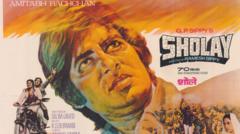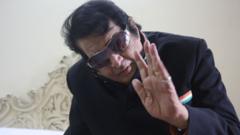After five decades, "Sholay," the monumental Hindi film, makes a triumphant comeback with its original ending and deleted scenes, promising an incredible experience for cinema enthusiasts.
Sholay's Cinematic Resurrection: A Fifty-Year Journey Back to the Big Screen

Sholay's Cinematic Resurrection: A Fifty-Year Journey Back to the Big Screen
Famed Bollywood classic Sholay returns with a restored version and a new ending, captivating audiences again after 50 years.
In a monumental cinematic event, the legendary film "Sholay" is set to make its grand return, exactly fifty years after its initial release. The world premiere of this fully restored and uncut version will occur at the Il Cinema Ritrovato Festival in Bologna, Italy, showcasing the film in all its glory, including its authentic ending previously altered due to censorship pressures.
Directed by Ramesh Sippy, "Sholay" debuted in 1975 and has since earned a revered status in Indian cinema, resonating deeply with audiences. Drawing inspiration from Western and samurai influences while retaining its distinctive Indian essence, it features an illustrious cast, including icons such as Amitabh Bachchan, Dharmendra, Hema Malini, and the unforgettable Amjad Khan as the fearsome bandit Gabbar Singh.
Originally, "Sholay" spanned 204 minutes and narrated a gripping good-versus-evil saga set in the fictional village of Ramgarh, where ex-convicts Jai and Veeru are hired by the former jailer Thakur Baldev Singh to take down Gabbar Singh. The film initially failed to charm critics despite its eventual box office success, running for an astonishing five years at Mumbai's Minerva theatre, later earning the title of "Film of the Millennium" in a BBC poll.
The film's dialogues have become entrenched in popular culture, frequently quoted at weddings and referenced in political speeches. Dharmendra called "Sholay" the "eighth wonder of the world." The film's original climax, in which Gabbar Singh meets a grim fate, had been censored due to its message of vigilante justice, prompting a hastily reshot ending for its theatrical release during India's politically repressive Emergency period.
Years of dedicated restoration work led to the recovery of original 35mm camera and sound negatives after they were discovered in an unmarked warehouse. Collaborating with organizations like the Film Heritage Foundation and the British Film Institute, archivists methodologically pieced the film's pieces back together, ensuring its first-ever fully restored screening would stay true to its roots.
Despite a tepid reception when first released, "Sholay" became a beloved cult classic, characterized by memorable soundtracks and iconic characters, including the chilling yet revered Gabbar Singh. Its enduring legacy can be attributed to its universal themes of justice and the triumph of good over evil, concepts reflected in Amitabh Bachchan's musings about the film's lasting impact.
Ultimately, "Sholay" remains a timeless piece of cinema, admired for its breathtaking visuals, engaging storytelling, and cultural significance, ensuring that it continues to captivate audiences, old and new.
Directed by Ramesh Sippy, "Sholay" debuted in 1975 and has since earned a revered status in Indian cinema, resonating deeply with audiences. Drawing inspiration from Western and samurai influences while retaining its distinctive Indian essence, it features an illustrious cast, including icons such as Amitabh Bachchan, Dharmendra, Hema Malini, and the unforgettable Amjad Khan as the fearsome bandit Gabbar Singh.
Originally, "Sholay" spanned 204 minutes and narrated a gripping good-versus-evil saga set in the fictional village of Ramgarh, where ex-convicts Jai and Veeru are hired by the former jailer Thakur Baldev Singh to take down Gabbar Singh. The film initially failed to charm critics despite its eventual box office success, running for an astonishing five years at Mumbai's Minerva theatre, later earning the title of "Film of the Millennium" in a BBC poll.
The film's dialogues have become entrenched in popular culture, frequently quoted at weddings and referenced in political speeches. Dharmendra called "Sholay" the "eighth wonder of the world." The film's original climax, in which Gabbar Singh meets a grim fate, had been censored due to its message of vigilante justice, prompting a hastily reshot ending for its theatrical release during India's politically repressive Emergency period.
Years of dedicated restoration work led to the recovery of original 35mm camera and sound negatives after they were discovered in an unmarked warehouse. Collaborating with organizations like the Film Heritage Foundation and the British Film Institute, archivists methodologically pieced the film's pieces back together, ensuring its first-ever fully restored screening would stay true to its roots.
Despite a tepid reception when first released, "Sholay" became a beloved cult classic, characterized by memorable soundtracks and iconic characters, including the chilling yet revered Gabbar Singh. Its enduring legacy can be attributed to its universal themes of justice and the triumph of good over evil, concepts reflected in Amitabh Bachchan's musings about the film's lasting impact.
Ultimately, "Sholay" remains a timeless piece of cinema, admired for its breathtaking visuals, engaging storytelling, and cultural significance, ensuring that it continues to captivate audiences, old and new.


















